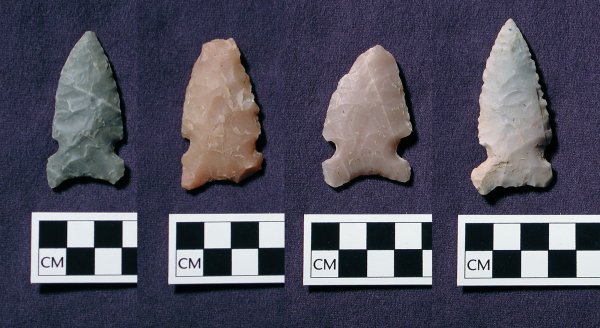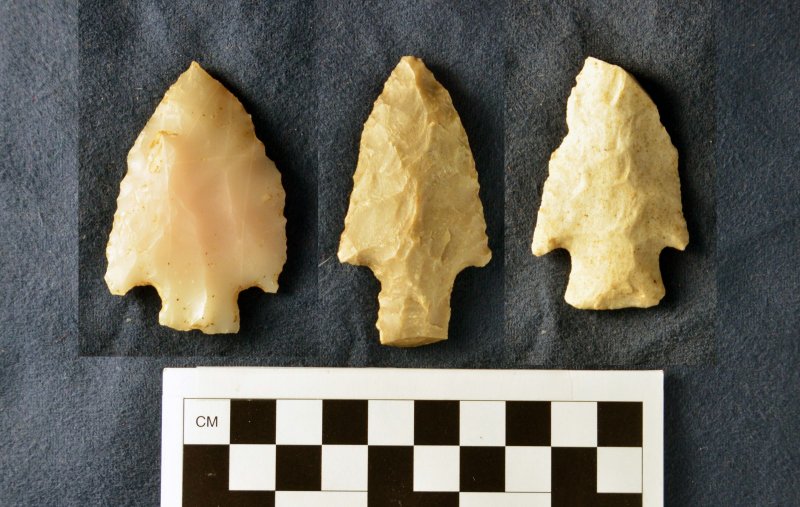How was novaculite used in the past?
Native Americans living in this region from about 11,500 B.C. to 1700 A.D. used novaculite for points to tip darts and arrows, for knife blades, and for scraping tools and drills. This rock was a key raw material used by Indians for chipping their sharp-edged tools. Since novaculite, like chert and flint, breaks with a “conchoidal fracture,” flintknappers can use that predictable cone-shaped fracture pattern to chip tools to the desired shape and thickness.

Conchoidal fracture of novaculite results in curved flake scars.
History “written” in stone
In the Ouachita Mountains and adjacent areas of the Gulf Coastal Plain in Arkansas, novaculite was preferred as a raw material for stone tools for thousands of years. This page illustrates some examples of novaculite dart and arrow points that tell us about Indian history in this region. These artifacts are all from past Arkansas Archeological Survey excavations, and all are made of novaculite.
Archeologists divide history in eastern North America into several time periods. These were once defined by characteristic foodways, community patterns, and technologies. As archeologists have learned more, the picture gets more complicated, and innovations once associated with one period are found in an earlier one. With increased use of radiocarbon dating, archeologists have refined our regional chronologies. We use changing styles of artifacts – like points that tipped darts and arrows – from excavated contexts at well-dated archeological sites as a material record of this long Indian history.
American Indians often say that they have always been here. Caddos, Quapaws, and other Indians of Arkansas have passed down stories about how people came to live here and how the world came to be. We can appreciate that there are different ways of looking at the past and learning about history.
Paleoindian period (11,500-10,500 B.C.). The earliest archeological evidence for people living in what is now Arkansas dates to about 11,500-10,500 B.C. (based on calibrated radiocarbon ages). Based on sites elsewhere in the United States, people lived in small communities that moved often, hunting large mammals that are now extinct like mammoth, mastodon, and large forms of bison. Artifacts associated with these sites include distinctive fluted projectile points such as “Clovis” style. While some Clovis points are known from sites in the Ouachita Mountains and elsewhere in Arkansas, only a few made from novaculite have been documented.
Archaic period (10,500 – 650 B.C.). Climate change at the end of the Pleistocene or Ice Age meant that people had to adapt to changes in plants and animals. In general, Archaic period peoples lived by hunting deer and other animals, fishing, and collecting wild plants for food, but several kinds of plants were domesticated for their nutritious seeds by the Late Archaic. New technologies were developed, from “atl-atls” (spear throwing sticks) to fish hooks and fish nets with net weights to grinding stones for processing nuts and seeds.
Late Paleo/Early Archaic (10,500-7000 B.C.). Late Paleoindian or Early Archaic dart point styles known as “Dalton,” “Scottsbluff,” and “San Patrice” are seen at a few archeological sites in this area. Points made during this time often had ground or smoothed bases, related to their technique of hafting onto handles. Some novaculite was used, but dark gray or black opaque chert seems to have been preferred for Dalton and San Patrice points in this region.

Early Archaic “Dalton” dart point from 3MN496 on left; on right, a point from 3GA854 that was reworked into an endscraper.
Middle Archaic (7000-4000 B.C.). During the Middle Archaic period, populations were larger, based on the increased visibility of artifacts like “Johnson” and “Big Sandy” or “White River Side Notched” style dart points, notched pebble net weights, and grooved axe heads. People were also probably more settled, living at their communities along river valleys through much of the year. Based on archeological data, Indians in Arkansas were actively quarrying novaculite from Ouachita Mountains sources during this period.

Middle Archaic “Johnson” dart points from site 3HS28 in Hot Spring County, Arkansas.
Excavations at 3HS28 led by Mary Beth Trubitt (Arkansas Archeological Survey) as part of Arkansas Archeological Society Training Programs in 2007-2008 provided new information about life in the Ouachita River Valley during the Middle Archaic period. Radiocarbon dates from charred nutshell from two concentrations of burned rock in the Middle Archaic stratum provided calibrated ages of 6020-5880 B.C. and 4350-4240 B.C. (2 sigma range). Analysis of artifacts, residues, and charred plants and fragments of animal bone as part of this project provides us with a picture of Middle Archaic foodways.

Middle Archaic “Big Sandy” or “White River Side Notched” dart points from site 3HS28 in Hot Spring County, Arkansas.
Late Archaic (4000-650 B.C.). Beginning in the Late Archaic period, Indians domesticated several plants (such as squash, sunflower, marsh elder, chenopodium, and little barley) for their oily or starchy seeds. Some evidence for plant domestication has been identified from sites in northwestern Arkansas dating to 1000 B.C., but little is known about the transition to agriculture in the Ouachita Mountains. Early mounds and earthworks are now known based on Middle and Late Archaic period sites in Arkansas and Louisiana, such as Poverty Point. Stemmed dart points, such as the “Bulverde,” “Williams,” and “Evans” styles, are typical in southern Arkansas.

Late Archaic stemmed dart points from site 3HS28 in Hot Spring County, Arkansas.
Woodland period (650 B.C. - A.D. 900). In the Ouachita Mountains region and in southwest Arkansas, the Woodland period is also known as the Fourche Maline culture. Typical artifacts on Fourche Maline sites are plain, thick-walled ceramic vessels, smoking pipes (for tobacco use), “Gary” style dart points, and double-bitted axes. The bow and arrow was invented and rapidly spread across the area after A.D. 600. Plum Bayou Mounds was a Late Woodland mound center in the Arkansas River Valley in central Arkansas. The use of novaculite and quartz crystal by people living at Plum Bayou Mounds showcases the Interactions that once took place between communities in different regions of Arkansas during the Woodland period.

Late Archaic to Woodland “Gary” style points from site 3HS28 in Hot Spring County, Arkansas.
Mississippian period (A.D. 900 – 1700). Caddo Indians lived in southwest Arkansas as well as neighboring areas of Oklahoma, Texas, and Louisiana during the Mississippian period. The ancestral Caddo Indians were farmers who grew maize and other domesticated plants, hunted deer, and fished, giving them a variety of foods. Their communities were made up of farmsteads scattered across good agricultural land along rivers, as well as political and religious centers with mounds. Variation in pottery decoration, arrow point styles, the construction and use of mounds for burials and other ceremonies, and foodways are seen across the region and through time.

Late Woodland to Mississippian period arrowpoints from site 3HS28 in Hot Spring County, Arkansas.
Excavations by the Arkansas Archeological Survey and Arkansas Archeological Society uncovered residues of wall posts from a Caddo building at site 3HS28 in 2008. The Caddo Indian community at this location dated to at least the 15th century based on a radiocarbon date of A.D. 1410-1460 (calibrated, 2 sigma range) from charred hickory nutshell from the fill of one of the postholes, reported by Trubitt, Parker, and Kelly in 2011.
European exploration of what is now Arkansas began in the 16th century with the Spanish expedition of Hernando De Soto. Caddo Indian communities continued to thrive in the Red River Valley in southwest Arkansas during the 17th and 18th centuries. Novaculite was used less frequently for arrow points and other tools, in favor of cherts from local river gravels. Following the Louisiana Purchase, Indian tribes in Arkansas were forced to give up land to the United States. With the Indian Removal Act of 1830, Cherokees and other eastern tribes passed through Arkansas on the Trail of Tears and similar removals. Settlers moving into Arkansas looked at novaculite as a whetstone rock for sharpening metal tools.
Read more about the history of novaculite tools in these references:
Coleman, Roger E. (2002) Novaculite Acquisition and Use at Little Missouri Falls: An Early Middle Archaic Site in Montgomery County, Arkansas. The Arkansas Archeologist 42:15-43.
Early, Ann M. (1988) Standridge: Caddoan Settlement in a Mountain Environment. Arkansas Archeological Survey Research Series No. 29, Fayetteville.
Early, Ann M., editor (2000) Forest Farmsteads: A Millennium of Human Occupation at Winding Stair in the Ouachita Mountains. Arkansas Archeological Survey Research Series No. 57, Fayetteville.
Harrington, Mark R. (1920) Certain Caddo Sites in Arkansas. Indian Notes and Monographs, Museum of the American Indian, Heye Foundation, New York.
Morrow, Juliet E. (2014) Arkansas Fluted Points Made from Novaculite, a Lithic Raw Material from the Ouachita Mountains. Field Notes (Arkansas Archeological Society Newsletter) 379:5-7.
Perttula, Timothy K. and Bo Nelson (2004) Certain Caddo Sites in the Ouachita Mountains of Southwestern Arkansas. Caddo Archeology Journal 13(3&4):21-56.
Schambach, Frank F. (2003) Tom’s Brook Culture: A Middle Archaic Period Culture of Southwestern Arkansas. Field Notes (Newsletter of the Arkansas Archeological Society) 314:9-15.
Schambach, Frank F. (2001) Fourche Maline and its Neighbors: Observations on an Important Woodland Period Culture of the Trans-Mississippi South. The Arkansas Archeologist 40:21-50.
Schambach, Frank F. (1998) Pre-Caddoan Cultures in the Trans-Mississippi South. Arkansas Archeological Survey Research Series No. 53, Fayetteville.
Trubitt, Mary Beth (2011) Another Archaic Period Date from Jones Mill. Field Notes (Newsletter of the Arkansas Archeological Society) 358:5-6.
Trubitt, Mary Beth (2009a) Communication: Investigating Middle Archaic at the Jones Mill Site. The Arkansas Archeologist 48:71-84.
Trubitt, Mary Beth (2009b) Putting an Age on the Archaic at Jones Mill. Field Notes (Newsletter of the Arkansas Archeological Society) 349:3-7.
Trubitt, Mary Beth, Kathryn Parker, and Lucretia Kelly (2011) Reconstructing Ancient Foodways at the Jones Mill Site (3HS28), Hot Spring County, Arkansas. Caddo Archeology Journal 21:43-70.
Wood, W. Raymond (1981) The Poole Site, 3GA3. The Arkansas Archeologist 22:7-65.
The Encyclopedia of Arkansas History & Culture (Central Arkansas Library System 2013) is a good source for online articles about these time periods in Indian history.
The Arkansas Archeological Survey’s Indians of Arkansas website is another good resource on Indian history.
Suggested citation format for this website:
Arkansas Archeological Survey 2016 "Arkansas Novaculite: A Virtual Comparative Collection."
http://archeology.uark.edu/novaculite/index.html (accessed January 15, 2016).
We welcome comments and feedback from you! For further information on this website, please contact Mary Beth Trubitt, Arkansas Archeological Survey, mtrubit@uark.edu.
This project is supported in part by a grant from the Arkansas Humanities Council and the National Endowment for the Humanities.
Copyright 2012, 2013, 2014, 2015, 2016 Arkansas Archeological Survey
A Division of the University of Arkansas System
2475 North Hatch Avenue
Fayetteville, AR 72704
479-575-3556
arkarch@uark.edu




